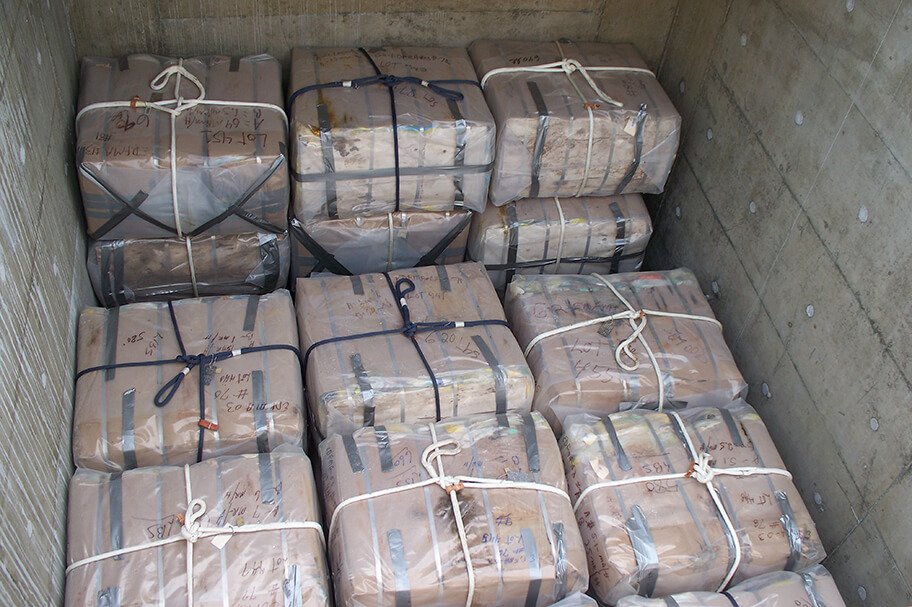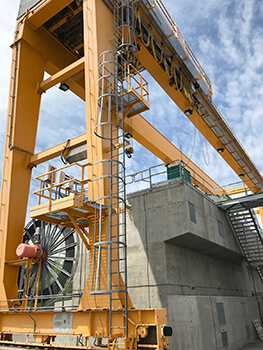Decommissioning of the Gentilly‑2 facilities
Management of solid radioactive waste and spent fuel
In addition to spent fuel, nuclear generating stations produce different types of solid radioactive waste that are distinguished primarily by their level of radioactivity.
Low- and intermediate-level radioactive waste is stored in waste storage facilities at Gentilly-2, either in the radioactive waste storage area, or, since 2009, in the new Solid Radioactive Waste Management Facility (SRWMF). Spent fuel is stored in the dry storage area. Management of radioactive waste and spent nuclear fuel involves stringent radiation protection and environmental monitoring procedures to protect workers, the public and the environment.
Key statistics
0.05% Percentage of low‑level radioactive waste produced in Canada by the Gentilly‑2 nuclear generating station
2.26% Percentage of intermediate‑level radioactive waste produced in Canada by the Gentilly‑2 nuclear generating station
4% Percentage of fuel bundles used at Gentilly‑2 nuclear generating station between 1983 and 2012 compared to all fuel bundles used by Canadian nuclear power plants
* According to
Natural Resources Canada’s Inventory
of Radioactive Waste in Canada 2019![]()
Radioactive Waste Storage Area (RWSA)
The Radioactive Waste Storage Area (RWSA) was built at the same time as the generating station. All of its contents are scheduled for transfer to the solid radioactive waste management facility by 2024. This transfer will have the added benefit of optimizing the monitoring area and keeping this waste in newer modules.
Solid Radioactive Waste Management Facility (SRWMF)

This storage facility was built in two separate phases and has several aboveground storage modules. Since 2009, the main types of waste stored there have been:
- low-level radioactive waste, consisting of rags, gloves, slightly contaminated clothing, mops and mechanical filters
- intermediate-level radioactive waste, consisting of purification resins and equipment parts used in nuclear systems.
Irradiated Fuel Dry Storage Area (IFDSA)
The irradiated nuclear fuel was removed from the Gentilly‑2 reactor core in 2013 and remained in a spent fuel pool for about seven years. It was transferred to CANSTOR dry storage modules, all of them located within the nuclear plant’s security perimeter.
Since December 2020, a total of nearly 130,000 spent fuel bundles have been stored inside the IFDSA’s CANSTOR dry storage modules where they will remain until a long-term management site has been prepared to receive all of the spent fuel bundles from all of Canada’s nuclear power plant operators.

Long-term radioactive waste management
Updated policy, strategy adopted
As part of the modernization of Canada’s
Policy for Radioactive Waste Management and
Decommissioning![]() , the Minister of Energy and Natural Resources Canada
mandated the
Nuclear Waste Management Organization (NWMO) to work with Indigenous peoples and the
rest of the population to develop the Integrated Strategy for Radioactive Waste. On
March 31, 2023, following a two-year public consultation, the revised Policy
, the Minister of Energy and Natural Resources Canada
mandated the
Nuclear Waste Management Organization (NWMO) to work with Indigenous peoples and the
rest of the population to develop the Integrated Strategy for Radioactive Waste. On
March 31, 2023, following a two-year public consultation, the revised Policy![]() was made
public. On October 5, 2023, Natural Resources Canada issued a press release welcoming
the Strategy
was made
public. On October 5, 2023, Natural Resources Canada issued a press release welcoming
the Strategy![]() ’s
recommendations. These were informed by an international comparative
analysis, an inventory of radioactive waste in Canada, technical evaluations and cost
estimates as well as the consultations held since 2021.
’s
recommendations. These were informed by an international comparative
analysis, an inventory of radioactive waste in Canada, technical evaluations and cost
estimates as well as the consultations held since 2021.
Spent nuclear fuel
Hydro-Québec is a member of the Nuclear Waste Management Organization (NWMO), which was established in 2002 under the Nuclear Fuel Waste Act. Its mission is to develop and implement a management approach for the long-term care of Canada’s used nuclear fuel that is socially acceptable, technically sound, environmentally responsible and economically feasible.
In 2007, the Minister of Natural Resources of Canada approved the NWMO recommendation for adaptive phased management (APM), which is both a technical method and a management system that can be adapted to changing technology and science and to evolving public policy. Its ultimate technical objective is the centralized containment and isolation of used nuclear fuel in a deep geological repository.
In 2008, the NWMO initiated a nation-wide public dialogue to determine the process to be used to select a geological storage site. In 2009, the NWMO held consultations concerning a siting process based on that dialogue. Information sessions were held in four Canadian provinces, including Québec (Montréal, Trois-Rivières and Québec). Some twenty proposals were considered, and the NWMO is now conducting preliminary assessments of the fitness of each of the two different sites still under study. The final selection is expected to be announced shortly.
The Integrated Strategy for Radioactive Waste recommends that the NWMO continue with the project to build a deep geological repository.
Find out more about the NWMO's
work![]()
Intermediate‑level radioactive waste
The 2023 Integrated
Strategy for Radioactive Waste![]() confirms that, in addition to
developing and implementing a solution for the long-term management of spent fuel, the
NWMO will also be in charge of applying an intermediate‑level waste management
solution.
A deep geological repository is the solution proposed by the NWMO following a
Canada-wide public consultation process.
confirms that, in addition to
developing and implementing a solution for the long-term management of spent fuel, the
NWMO will also be in charge of applying an intermediate‑level waste management
solution.
A deep geological repository is the solution proposed by the NWMO following a
Canada-wide public consultation process.
Low-level radioactive waste
The Integrated
Strategy for Radioactive Waste![]() recommends that
low-level
radioactive waste
generators and owners remain responsible for implementing long-term disposal in keeping
with international best practices, taking into account characteristics, volume,
proximity to the existing interim waste facilities, community acceptance and technical
considerations. Building near-surface disposal facilities for low-level waste is one of
the Strategy’s recommendations.
recommends that
low-level
radioactive waste
generators and owners remain responsible for implementing long-term disposal in keeping
with international best practices, taking into account characteristics, volume,
proximity to the existing interim waste facilities, community acceptance and technical
considerations. Building near-surface disposal facilities for low-level waste is one of
the Strategy’s recommendations.
“The option of multi-waste producer facilities or centralized regional facilities to also be explored to balance the number of facilities with the distance that the waste would need to be transported. Centralized regional facilities could provide economies of scale and could ensure fair access to disposal facilities for small waste generators. Regional facilities could be provincial, cover multiple provinces or be multiple facilities within one province, depending on several factors such as volume of waste, transportation distances and cost.”
“More detailed implementation plans by waste generators and waste owners to be developed in an open and transparent manner, with early and ongoing engagement consistent with the Policy.”
– Nuclear Waste Management Organization, Integrated
Strategy for Radioactive
Waste![]() , p. 54.
, p. 54.
Connect with us
We’re committed to keeping the lines of communication open. Please send us your questions and comments about the project.
